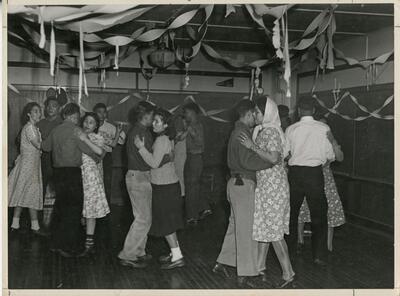| 1 — | Typed caption on back: Alaska, Little Diomede Island. Under a canopy of crepe paper and
colored lights, you would never guess this to be a group of Diomede Eskimo enjoying a “white
dance” to the music of a phonograph. Date stamp: Rec’d Oct 30 1950. [at AFN 2014, location
tentatively identified as Nome High School gym, individuals identified as, left to right: Theresa
Omiak?, John Iyapana, [unknown], Cecilia Omiak, James Iyapana, [unknown], Sophie Omiak,
[unknown couple], Albert Iyahuk, Annie Iyapana Iyahuk, [unknown couple]]
|

